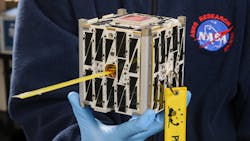To open space exploration to the upcoming generation of researchers, smaller, less costly satellites are being used. NASA’s Small Spacecraft Technology mission, for example, uses nanosatellites known as cubesats. Recently, PhoneSat 2.4 from that mission completed checkout and sent back data confirming that all systems were “go” after its launch in November 2013. The PhoneSat mission hopes to confirm the viability of using smartphones and other commercially available electronics in satellites destined for low-Earth orbit.
PhoneSat 2.4 measures approximately 4 in.2 and weighs only 2.2 lbs. It uses a two-way S-band radio, allowing engineers to command the satellite from Earth. The main guts of the satellite are a Nexus S smartphone running on an Android operating system (OS). With an expected orbital lifetime of up to a year, PhoneSat 2.4 will measure how well commercially developed components perform in space over an extended period of time. The program aims to take advantage of the off-the-shelf devices that already have similar systems to those needed for spacecraft but are ultra-small—a sort of “less is more” approach.
The smartphone provides many of the normal functions that satellites need to operate including memory, computation, communications interfaces, power, and navigation. The data from the satellite’s subsystems—including the smartphone, power system, and orientation control system—are downlinked over amateur radio at 437.425 MHz.
PhoneSat 1.0 was successfully demonstrated for a week in April 2013 while PhoneSat 2.5 is scheduled to launch in February 2014 aboard a commercial SpaceX rocket.
The PhoneSat series is the pathfinder for the overall Edison Demonstration of Smallsat Networks (EDSN) mission, which comprises eight identical 1.5-unit cubesats. The mission will use many small spacecraft in a coordinated cluster to study the space environment and communications techniques. Each cubesat will have a Nexus 5 smartphone for satellite command and data handling and a designated scientific instrument added as a payload. In addition, every cubesat will take its own science measurements, transmitting data to the others or collecting for transmission to the ground station. This added versatility in command and control could potentially be translated to larger groups of satellites to affordably monitor the Earth’s climate, space weather, and other phenomena.
About the Author
Iliza Sokol
Associate Digital Editor
Iliza joined the Penton Media group in 2013 after graduating from the Fashion Institute of Technology with a BS in Advertising and Marketing Communications. Prior to joining the staff, she worked at NYLON Magazine and a ghostwriting firm based in New York.
